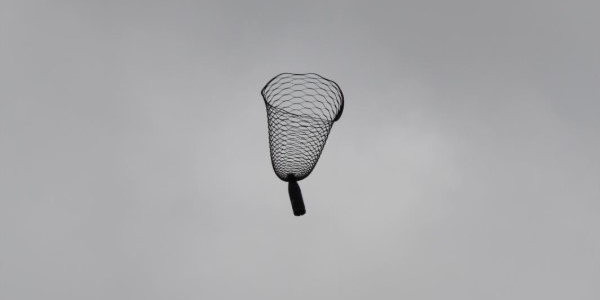
A research team from the mechanical engineering department at Polytechnique Montréal has designed a new parachute concept inspired by kirigami, the Japanese art of paper folding and cutting. Possible applications range from new ways for humanitarian missions to deliver food, water and medicine to space exploration.
Frédérick Gosselin (pictured above, at left) , a professor in Polytechnique’s Mechanical Engineering Department, came up with the deceptively simple idea after attending a conference in the USA, where a researcher demonstrated how a sheet of plastic changes shape after it’s cut into a specific kirigami pattern known as the ‘closed loop’.
‘Cutting a sheet into this type of pattern endows it with new mechanical properties, which is what the researchers were mainly interested in,’ he explained. To test its properties, the researchers attached a weight to the middle of the kirigami sheet. The sheet deformed and stretched into an inverted bell to support the weight.
‘When I saw this image and discussed it with Sophie Ramananarivo, professor at the École Polytechnique in France and co-author of the study, I started wondering how a sheet cut with this pattern would behave in free fall and whether it could potentially act as a parachute,’ he continued. ‘I wondered how a sheet cut into this pattern would behave in free fall and whether it could act as a parachute.’ However, he didn’t pursue the idea at the time.
The idea floated around until David Mélançon (pictured above, at right), a specialist in foldable structures inspired by origami and kirigami, was hired by Polytechnique Montréal. The young researcher jumped on his colleague’s suggestion as a promising avenue to explore.
The duo entrusted the project to Danick Lamoureux (pictured above, centre), a Master’s student at the time. His mission was to tweak the pattern to increase its air resistance. In other words, he had to find ways to reduce the parachute’s aerodynamic efficiency, which directly influences its performance.
After extensive testing, Lamoureux was ready to demonstrate the results to his supervisors. He attached a small weight to the centre of the parachute and threw it into the air. The moment has remained etched in Mélançon’s memory.
‘What happened next really surprised me,’ recalled Mélançon. ‘The parachute stabilised immediately before floating down, unlike a conventional parachute. That’s when I knew we were onto something.’
When deployed, a parachute traps air beneath it, creating drag that slows its rate of descent. The amount of drag depends directly on the parachute’s aerodynamics, which is influenced by the parachute’s shape and composition, and the airflow around it. The less aerodynamic a parachute is, the more drag it will generate. But drag isn’t all good. Excessive drag generates chaotic vortices above the parachute, making its descent path unpredictable.
Several prototypes and dozens of drops later, the research team at Polytechnique’s Laboratory for Multiscale Mechanics believes it has found the optimal closed-loop pattern for a kirigami-inspired parachute.

Their parachute differs from a conventional hemispherical parachute in several ways. Not only does it stabilise quickly after release, but it deploys in a more orderly manner than a conventional parachute, since its payload is held by a single suspension line, rather than several lines that can become entangled.
‘It’s a consistently stable parachute that doesn’t need to be folded in any special way to open correctly,’ explained Mélançon. ‘It can be released in any way and will fall straight down, unlike a conventional parachute, which tends to drift.’
Its trajectory in free fall is also different, according to the researchers. When released above a target, it will land very close to it, unlike a conventional parachute. ‘The inverted bell shape stretches the slits of the kirigami pattern and forces the air through its numerous small openings,’ explained Gosselin. ‘This causes the airflow to remain orderly, without large chaotic vortices, resulting in a predictable trajectory.’
Another significant advantage of the kirigami parachute is that it can be manufactured using readily available materials and equipment at low cost. ‘Basically, all you need is a paper or plastic sheet and a laser or a die-cutting press,’ said Mélançon. ‘There’s no stitching involved and it’s very simple to assemble.’
According to Mélançon, these features could make the parachute useful for delivering humanitarian aid. Food is sometimes air-dropped without a parachute, knowing that some of the bags will break to absorb the shock. When a standard hemispherical parachute is used, a different issue arises: besides the cost of manufacturing and the time spent handling the parachutes, air turbulence makes it impossible to control the descent, and the cargo may land far from its intended target.
‘The kirigami-inspired parachute could prove to be the best solution for this use case,’ said Mélançon. ‘It might also be used for parcel deliveries in remote areas or even space exploration Mars.’
But before aiming for the solar system, the Polytechnique team will explore ways to endow its parachute with new properties, a task entrusted to graduate student Jérémi Fillion, who is also a co-author of the paper. ‘By modifying the cutting pattern, we could, for example, make the parachute descend in a spin, or glide sideways before dropping,’ said Mélançon.
The research team is also investigating how the parachutes could sort their cargo by weight. ‘We could have parachutes that move to one side if they are carrying water, while those carrying a lighter payload would move to the other side, so the cargo would be sorted as soon as the parachutes are released,’ he suggested. ‘The idea is to see how we can program the descent in different ways.’
The research has been published in Nature.


